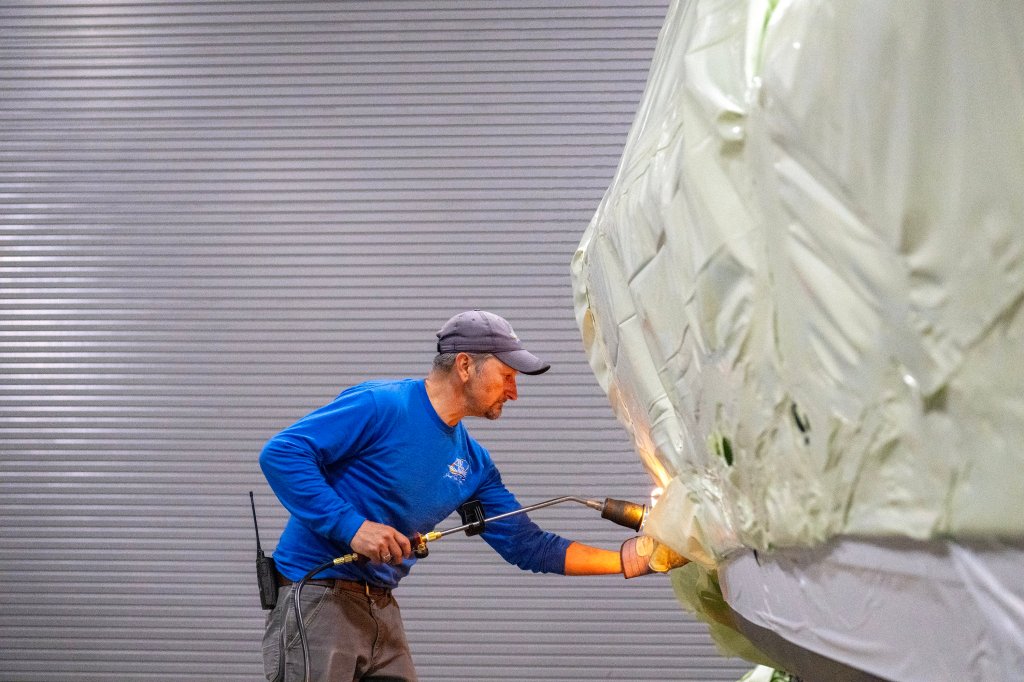
SOUTH PORTLAND — Kevin Murphy stood on the top rung of a ladder, sweeping a propane torch along plastic wrap shrouding a 22-foot boat.
The torch hummed, and the pale green plastic melted into itself, bubbling and wrinkling before becoming smooth and firm.
The material clung to the Robalo, revealing its imprint from the previously shapeless draping.
Murphy, a service helper for Port Harbor Marine’s South Portland location, has winterized about 150 boats this season.
This year, all of the boats at the company’s five Maine locations, from Rockport to Kittery, will be wrapped in BioWrap, a single-use biodegradable plastic boat wrap made by a Rhode Island company called Bioaqualife. The pale green shrink wrap costs about 20% more than standard wrap but claims to be an eco-friendly alternative.
Each year, as much as 1.5 million pounds of plastic from Maine boat wrap ends up in landfills, where it breaks down into microplastics and releases harmful chemicals into the environment, according to Emily Carey Perez de Alejo, executive director of Defend Our Health, a statewide nonprofit that advocates against the use of toxic materials.
There are more than 100,000 registered boats in Maine, and it takes 15-30 pounds of plastic to wrap each boat each year, Carey Perez de Alejo said. Recycling the material is often inaccessible, she said, requiring compliance with strict rules like keeping it clean, which many marinas have determined is more trouble than it’s worth.
“If it’s easier to, people are going to throw it out,” Carey Perez de Alejo said.
BioWrap is marketed as being able to be sent straight to the landfill, where it breaks down into water, biogas and carbon within four years and does not leave traces of microplastics or heavy metals, founder Simon Milne said in a recent interview. He cited a study conducted by Eden Research Laboratory and commissioned by Bioaqualife that showed that about half of a sample of BioWrap had degraded after two years.
The company embeds a formula into its wrap that allows it to be digested by microbes in the landfill, changing the material’s chemical structure, Milne said. Traditional plastics break down into smaller plastics, and the process can take hundreds of years. Compostable plastics can degrade within 90 days at industrial facilities but can also leave behind microplastics.
Milne started researching and developing this product nearly 10 years ago, after he moved to Rhode Island and was struck by the quantity of plastic boat wrap being shed each spring.
“What a disaster,” Milne said. “Our whole idea was if it’s going to go into a landfill, let’s make it biodegradable.”
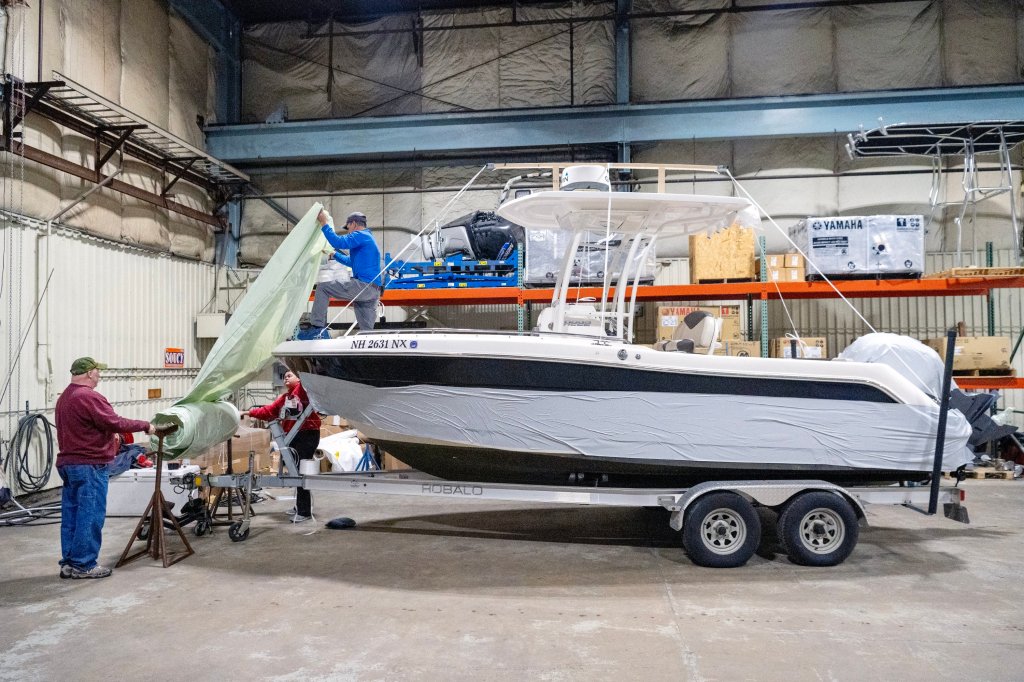
There are other companies offering similar products, but it is unclear whether they are used in Maine.
Port Harbor Marine was encouraged by Bioaqualife’s easily disposable yet environmentally conscious option.
“We haven’t been comfortable in a long time with the amount of plastic going into the landfill,” said Jim Petersen, the service director at the South Portland location.
The company wraps about 3,000 boats annually, using more than 50,000 pounds of plastic. Almost all of it — except the pieces picked up by locals to make at-home ice rinks — was sent straight to the dump.
Port Harbor Marine seriously contemplated recycling four years ago, but the requirements proved to be too strict and labor-intensive. The recycling company required that the plastic be completely clean, which is difficult when removing wrap in windy and damp conditions. It wanted the plastic to be free of all strings, doors, zippers and tape, and it wanted the marina to fold and keep the plastic in a storage container.
“If it was a smaller volume, we probably could have done it,” Petersen said.
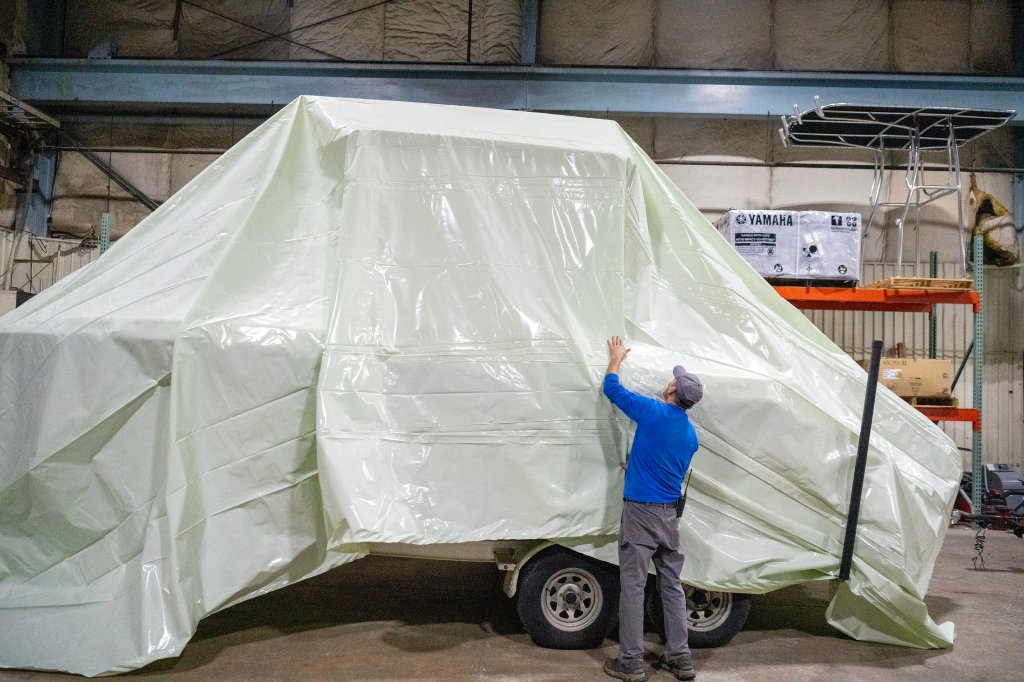
Murphy is still getting used to the new material, which shrinks at a lower temperature, making it more prone to holes. And it sticks to itself, making it harder to unfurl.
“We’ll have to go through the winter to see how it holds up,” Murphy said.
Experts question whether the new kind of wrap is as beneficial as it seems.
From sandwich bags to boat wrap, the plastic films sector is a sizable, problematic waste stream that can produce harmful heat-trapping greenhouse gases and microplastics upon disposal, said Margaret Sobkowicz Kline, a plastics engineering professor at the University of Massachusetts, Lowell.
When it comes to plastic wrap made from fossil fuels, biodegradability shouldn’t be the goal, Sobkowicz Kline said. That is just taking carbon out of the ground, where it poses no climate threat, and creating a product that will eventually end up in a landfill, resulting in methane and carbon dioxide emissions that drive up temperatures.
“That’s not a great endpoint,” Sobkowicz Kline said. “It’s no different, really, than burning it in our cars.”
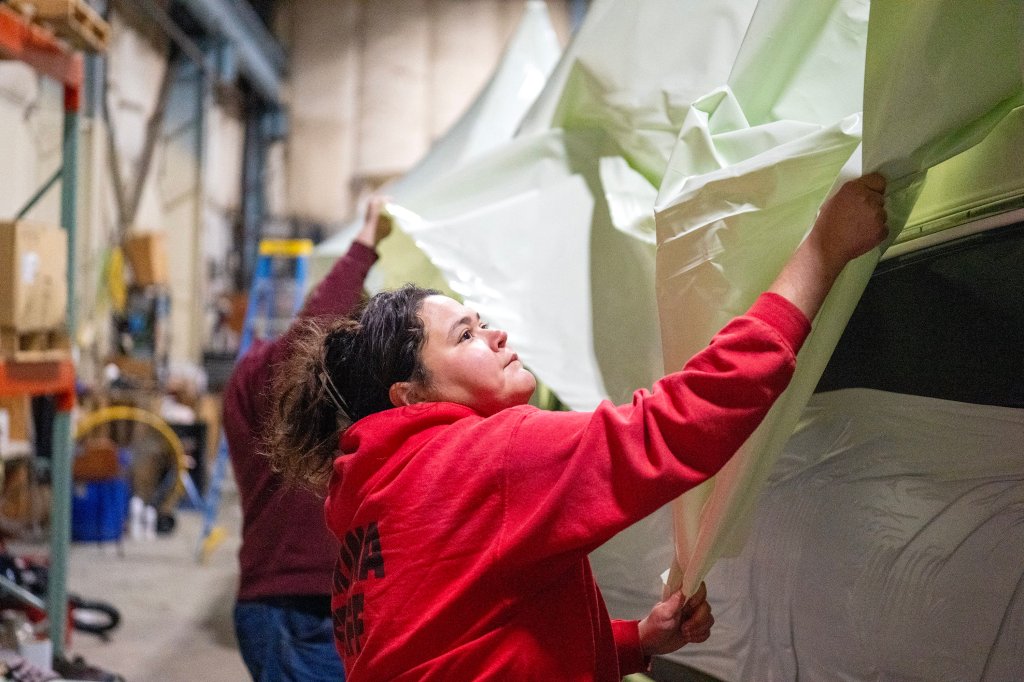
Nataliya Zagorodnova, a communications representative for Bioaqualife, said that all landfills produce methane as a byproduct. She said that their boat wrap does not cause or increase methane beyond landfill processes. She did not comment on sequestered carbon emissions.
Sobkowicz Kline, whose expertise is in environmental sustainability, said it would be better for a boat owner, marina operator or wrapping company to focus on reusing or recycling the oil-derived plastic wrap so it doesn’t end up in a landfill, although she acknowledged it can be hard to do.
She urged policymakers to consider regulations or legislation to encourage recycling in this sector and to consider ways to combine boat wrap with other industrial plastic films, like the plastic mulching used on a lot of Maine farms to control weeds, conserve moisture and regulate ground temperature.
That might create enough of a market to make it worth a recycling company’s time, she said.
Even better yet, Sobkowicz Kline urged companies like Bioaqualife to develop compostable plant-based films like those used in food packaging.
Carey Perez de Alejo said that boat owners should consider moving away from single-use plastic wraps, instead opting for reusable canvas covers. They might be more expensive and not as tight of a fit, but to her, the flaws are not enough to “outweigh the enormous amount of plastic trash that is being produced.”
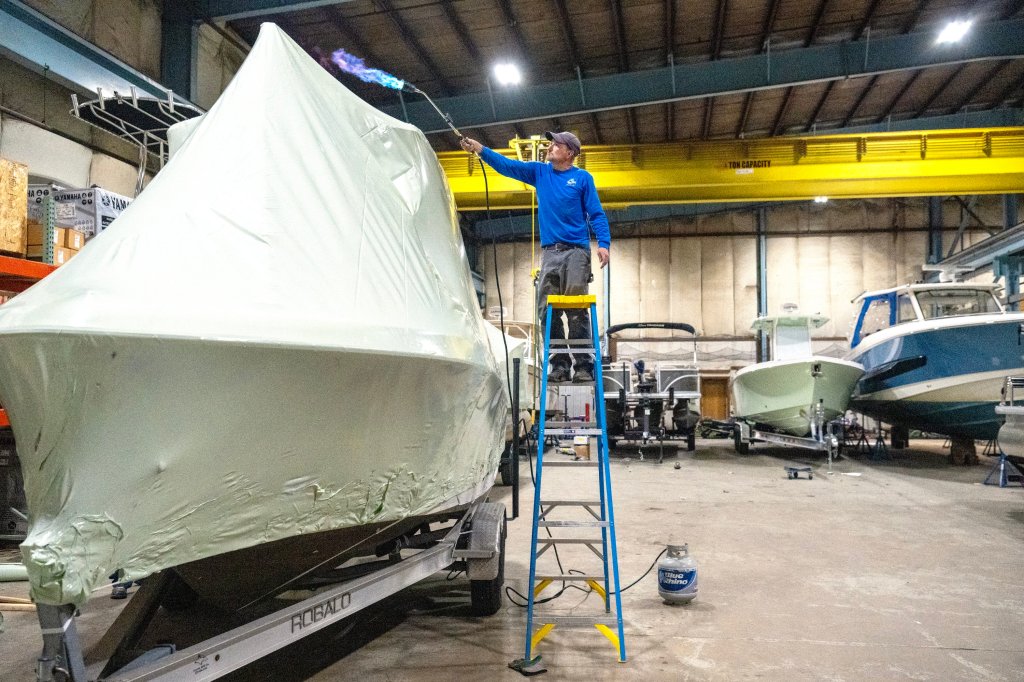
Some in the boating industry have remained hesitant about this new technology.
Benjamin Holloway, the owner of The Shrink Wrapper based in Woolwich, said he feels like his company is one of the few that hasn’t made the switch.
BioWrap is more expensive per roll while yielding less material, something that doesn’t seem cost effective for him.
And he’s proud that his company recycles. His parents, who started the business in 1996, purchased a baler, and they taught him that it’s the right thing to do.
“If something you’re doing is polluting, then you should be responsible for cleaning up,” he said.
He wraps an average of 500 boats and recycles about 15,000 pounds per year. He makes a little over a thousand dollars each year for recycling materials after paying for an intermediary service, storage and transportation.
“I have a hard time changing what I’ve been doing for the past decades because one company comes along,” he said.
Editor’s note: This story was updated Oct. 31 to clarify differences between compostable and tradidional plastics.

